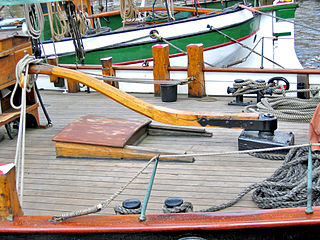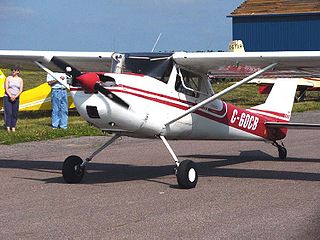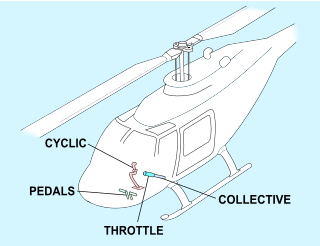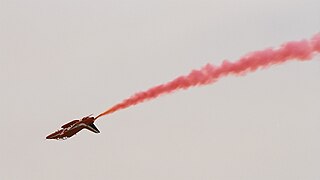
A rudder is a primary control surface used to steer a ship, boat, submarine, hovercraft, airship, or other vehicle that moves through a fluid medium. On an airplane, the rudder is used primarily to counter adverse yaw and p-factor and is not the primary control used to turn the airplane. A rudder operates by redirecting the fluid past the hull or fuselage, thus imparting a turning or yawing motion to the craft. In basic form, a rudder is a flat plane or sheet of material attached with hinges to the craft's stern, tail, or after end. Often rudders are shaped so as to minimize hydrodynamic or aerodynamic drag. On simple watercraft, a tiller—essentially, a stick or pole acting as a lever arm—may be attached to the top of the rudder to allow it to be turned by a helmsman. In larger vessels, cables, pushrods, or hydraulics may be used to link rudders to steering wheels. In typical aircraft, the rudder is operated by pedals via mechanical linkages or hydraulics.

Aircraft flight control surfaces are aerodynamic devices allowing a pilot to adjust and control the aircraft's flight attitude.

A conventional fixed-wing aircraft flight control system (AFCS) consists of flight control surfaces, the respective cockpit controls, connecting linkages, and the necessary operating mechanisms to control an aircraft's direction in flight. Aircraft engine controls are also considered flight controls as they change speed.

A tiller or till is a lever used to steer a vehicle. The mechanism is primarily used in watercraft, where it is attached to an outboard motor, rudder post or stock to provide leverage in the form of torque for the helmsman to turn the rudder. A tiller may also be used in vehicles outside of water, and was seen in early automobiles.

Conventional landing gear, or tailwheel-type landing gear, is an aircraft undercarriage consisting of two main wheels forward of the center of gravity and a small wheel or skid to support the tail. The term taildragger is also used.

A yoke, alternatively known as a control wheel or a control column, is a device used for piloting some fixed-wing aircraft.

Trim tabs are small surfaces connected to the trailing edge of a larger control surface on a boat or aircraft, used to control the trim of the controls, i.e. to counteract hydro- or aerodynamic forces and stabilise the boat or aircraft in a particular desired attitude without the need for the operator to constantly apply a control force. This is done by adjusting the angle of the tab relative to the larger surface.

A vertical stabilizer or tail fin is the static part of the vertical tail of an aircraft. The term is commonly applied to the assembly of both this fixed surface and one or more movable rudders hinged to it. Their role is to provide control, stability and trim in yaw. It is part of the aircraft empennage, specifically of its stabilizers.
The critical engine of a multi-engine fixed-wing aircraft is the engine that, in the event of failure, would most adversely affect the performance or handling abilities of an aircraft. On propeller aircraft, there is a difference in the remaining yawing moments after failure of the left or the right (outboard) engine when all propellers rotate in the same direction due to the P-factor. On turbojet and turbofan twin-engine aircraft, there usually is no difference between the yawing moments after failure of a left or right engine in no-wind condition.

Helicopter flight controls are used to achieve and maintain controlled aerodynamic helicopter flight. Changes to the aircraft flight control system transmit mechanically to the rotor, producing aerodynamic effects on the rotor blades that make the helicopter move in a desired way. To tilt forward and back (pitch) or sideways (roll) requires that the controls alter the angle of attack of the main rotor blades cyclically during rotation, creating differing amounts of lift at different points in the cycle. To increase or decrease overall lift requires that the controls alter the angle of attack for all blades collectively by equal amounts at the same time, resulting in ascent, descent, acceleration and deceleration.

USAir Flight 5050 was a passenger flight that crashed on takeoff from LaGuardia Airport in Queens, New York. As the plane took off from LaGuardia's runway 31, the plane drifted to the left. After hearing a loud bang, the pilots attempted to reject the takeoff, but were unable to stop the plane short of the end of the runway. The plane continued past the end of the runway and plunged into Bowery Bay. Two passengers were killed.
A yaw damper is a system used to reduce the undesirable tendencies of an aircraft to oscillate in a repetitive rolling and yawing motion, a phenomenon known as the Dutch roll. A large number of modern aircraft, both jet-powered and propeller-driven, have been furnished with such systems.

Ohio State University Airport is a public airport six miles (10 km) northwest of downtown Columbus, in Franklin County, Ohio, United States. It is owned and operated by Ohio State University in Columbus. It is also known as the OSU Don Scott Airport, named after Donald E. Scott, an OSU alumnus who died during his training as a pilot in the United Kingdom during World War II. The airport's main entrance is located on Case Road, and is easily accessible from OH-315 and Interstate 270.

P-factor, also known as asymmetric blade effect and asymmetric disc effect, is an aerodynamic phenomenon experienced by a moving propeller, wherein the propeller's center of thrust moves off-center when the aircraft is at a high angle of attack. This shift in the location of the center of thrust will exert a yawing moment on the aircraft, causing it to yaw slightly to one side. A rudder input is required to counteract the yawing tendency.

The yaw string, also known as a slip string, is a simple device for indicating a slip or skid in an aircraft in flight. It performs the same function as the slip-skid indicator ball, but is more sensitive, and does not require the pilot to look down at the instrument panel. Technically, it measures sideslip angle, not yaw angle, but this indicates how the aircraft must be yawed to return the sideslip angle to zero.

An aircraft in flight is free to rotate in three dimensions: yaw, nose left or right about an axis running up and down; pitch, nose up or down about an axis running from wing to wing; and roll, rotation about an axis running from nose to tail. The axes are alternatively designated as vertical, lateral, and longitudinal respectively. These axes move with the vehicle and rotate relative to the Earth along with the craft. These definitions were analogously applied to spacecraft when the first crewed spacecraft were designed in the late 1950s.

The SZD-6x Nietoperz was a single-seat tail-less experimental glider aircraft that was designed and built in Poland at Szybowcowy Zakład Doświadczalny in Bielsko-Biała in 1951. Only one example was constructed.
Cambridge Municipal Airport is three miles south of Cambridge, in Guernsey County, Ohio. The FAA's National Plan of Integrated Airport Systems for 2011–2015 categorized it as a general aviation facility.

A slow roll is a roll made by an airplane, in which the plane makes a complete rotation around its roll axis while keeping the aircraft flying a straight and level flightpath. A slow roll is performed more slowly than an aileron roll; although it is not necessarily performed very slowly, it is performed slowly enough to allow the pilot to maintain balance, keeping a steady flightpath, pitch angle, and height (altitude) throughout the maneuver. The maneuver is performed by rolling the airplane at a controlled rate with the ailerons, and moving the elevators and rudder in opposition, or "cross-controlling," to keep the plane on a steady, level flightpath.

A falling leaf is a maneuver in which an aircraft performs a wings-level stall which begins to induce a spin. This spin is countered with the rudder, which begins a spin in the opposite direction that must be countered with rudder, and the process is repeated as many times as the pilot determines. During the maneuver, the plane resembles a leaf falling from the sky; first slipping to one side, stopping, and then slipping to the other direction; continuing a side-to-side motion as it drifts toward the ground.
















